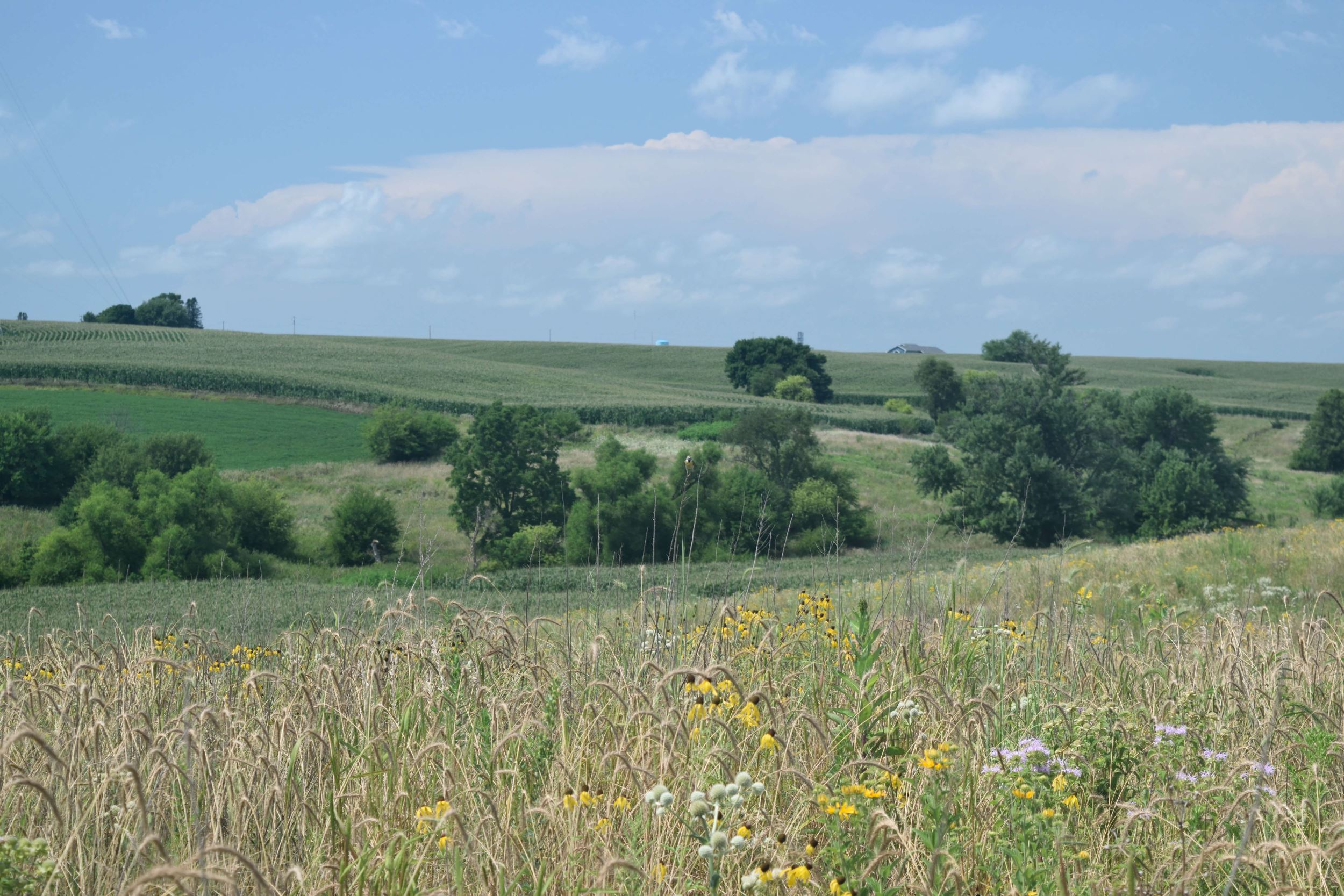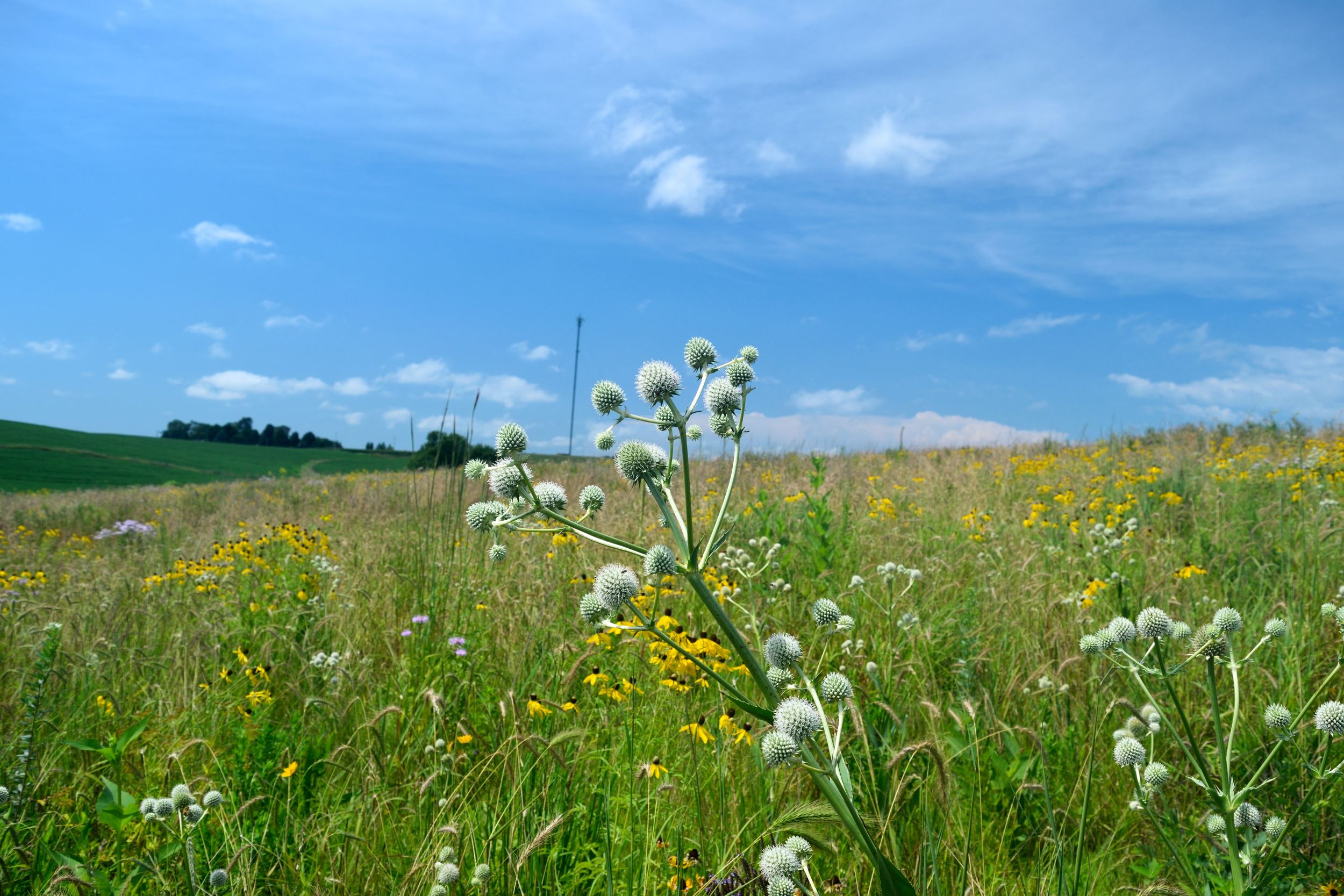Family farm lives on through INHF
By Anita O'Gara on December 9, 2016 in Landowner Stories

Part of Lanz Heritage Farm was enrolled in the Conservation Reserve Program after INHF received the farm in a bequest from Bobbie Lanz. Erosion on these slopes that were planted to permanent vegetation will be reduced to just 0.4 tons of soil per acre, down from 4.5 to 7.1 tons per acre. Photos by Ross Baxter/INHF
The late Bobbie Lanz inherited family land near Newton from her mother. As a single woman without children, it was up to her to determine the next chapter in this land’s story.
Bobbie chose to bequeath this 192-acre farm to Iowa Natural Heritage Foundation. Bobbie never spoke with INHF staff about her intentions, and her will mentioned no restrictions or expectations. With surprise and gratitude, the INHF staff and board set out to determine how best to live up to this woman’s trust and determine the land’s future.
Possibilities
Bobbie may have assumed INHF would sell this land so that its proceeds could support our work and mission. Most land donations to nonprofits are handled this way, and many land donors intend that to happen.
Because INHF’s mission is focused on Iowa land and natural resources, we pause to examine other possibilities.
Ross Langmaid, the young tenant who had been farming the land, helped us learn about the land’s needs and possibilities. Certain cropped hillsides on this rolling farm were losing topsoil. Ross pointed out areas that he believed should be enrolled in CRP and planted to prairie grassland to hold the soil.
We sensed how much great wildlife habitat could be restored on the farm while conserving the soil. We learned that the remaining cropland would provide many thousands of dollars for our mission, year after year.
Perhaps most exciting, this was an opportunity to practice how conservation and farming fit together. INHF President Joe McGovern says, “We wanted to try more things that improve land for farming and for conservation simultaneously. That’s the attitude we’d love to see on every farm across Iowa’s landscape.”
In 2011, INHF decided to keep the farm Bobbie entrusted to us. We made a commitment to land management that benefits soil, water and wildlife while providing income. And we named the farm after Bobbie: Lanz Heritage Area.
Step by step with intention
We gathered a planning team to help raise the land to its optimal level of both agricultural production and conservation.
The management plan is based on NRCS staff observations, LiDAR maps that help identify potential areas of erosion, Langmaid's ideas for improvements to the land, and INHF’s expertise in restoring natural areas.
Local ecotype prairie seed was planted on four steeply sloped areas: 43 acres in all. Ross helps manage the weeds while native flowers and grasses become established, and he donated his time and expertise to help repair eroded areas and seed new grass waterways. Ross continues to rent the cropland under a lease that includes conservation goals.
Lanz Heritage Area is not a perfect showcase or demonstration farm. “It’s a process,” said Ryan Schmidt, INHF land stewardship director. “There’s always a next step. We’re out to continually improve our conservation farming. We’ve got so many ideas and goals. There are plenty of hurdles and there’s plenty to learn, but our mission keeps us focused on doing better all the time.”

Impact is growing
“Now that the CRP is in place, I’ve already seen soil retention improvement on the land,” Langmaid said. The NRCS office estimates erosion on these slopes will be reduced to just 0.4 tons of soil per acre, down from 4.5 to 7.1 tons per acre.
In 2017, INHF participated in a study that looked at the impact of prairie strips (in-field and edge-of-field strips of reconstructed prairie installed on agricultural land) on bird, bee and reptile habitat. The Lanz Heritage Farm prairie reconstructions played host to a grassland nest survey conducted that summer. A total of 71 bird nests were found on 23 acres of prairie.
"A property that came to INHF almost entirely row-cropped has now been partially restored to provide a valuable place for wildlife," said Schmidt. "The study area, which is an island of prairie surrounded by row crops, has become a thriving piece of habitat. As we move forward, this property will only continue to get better."
Another especially satisfying result has been seeing pheasants make themselves at home on the Lanz farm. They had been gone from the area for a long while.
Joe McGovern reflects, “We think of Bobbie Lanz often with gratitude — not just when we’re making plans for the farm, but also as we put its income to work for Iowa nature. She created a really important conservation legacy, and we’re humbled and excited to be a part of it into the future.”